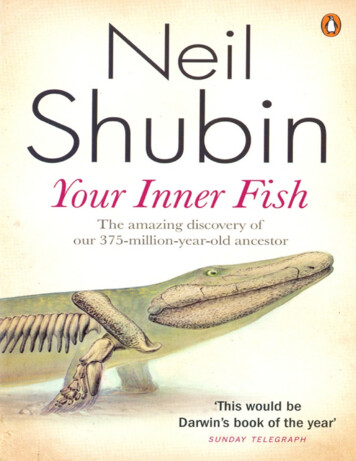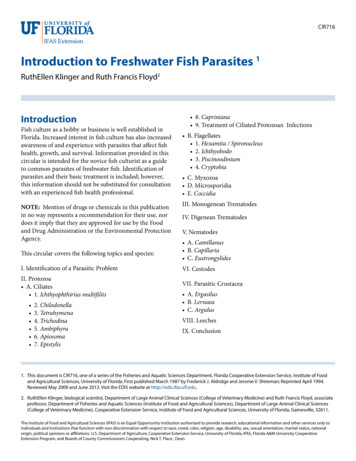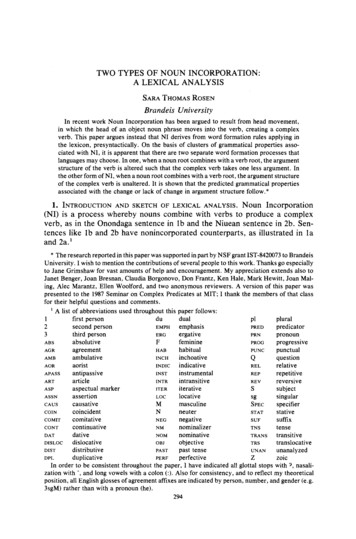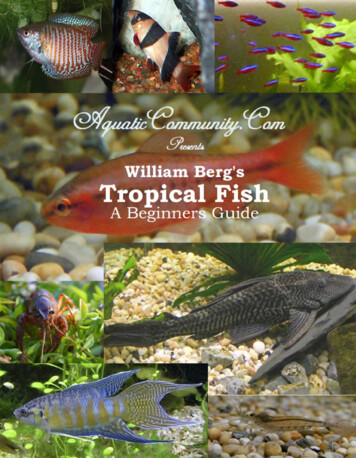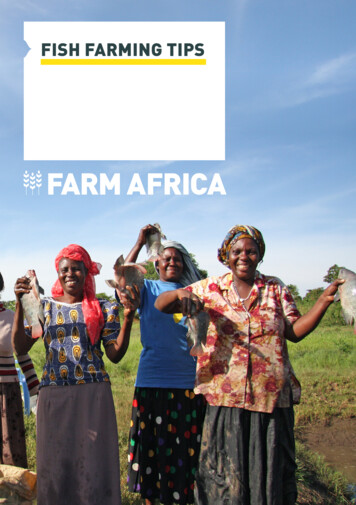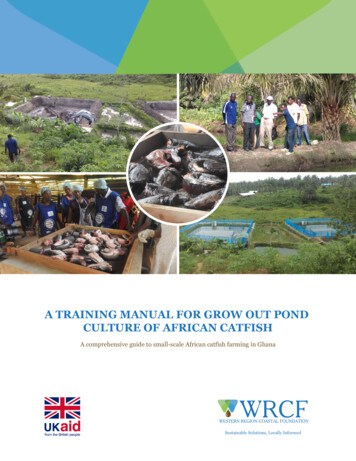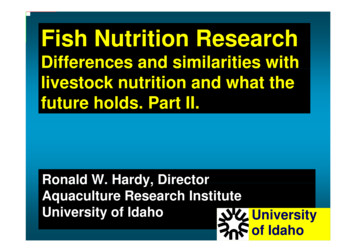
Transcription
Fish Nutrition ResearchDifferences and similarities withlivestock nutrition and what thef tfuturehholds.ld PartP t II.IIRonald W. Hardy, DirectorAquaculture Research InstituteUniversity of IdahoUniversityUiitof Idaho
Current areas of emphasispin fishnutrition research Replacing marine protein and oil Effects of nutrition on food quality andfish health Developing micro-particulate feeds forsmallll larvaelat firstfifeedingf di How can these areas be investigatedusing new genomic tools?
Replacing marine protein and oil Rapid growth of aquaculture over the past 15 years isdue to:– Industry growth in developed species–expanded production of new species–Switch from extensive to intensive production of pond fishththroughh hihigherh feedf d inputsit ini SE AsiaA i andd ChinaChi Proportion of annual global production of fish meal andfish oil used by aquaculture has tripled Production of fish meal and oil cannot increase exceptin Alaska byy increased recoveryy of pprocessingg waste Only way to meet expected demand for protein and oil inaquafeeds is to find alternatives to fish meal and oil
World fish meal use in livestock andfish feeds in 1994, 2000 & 0002006
World fish feed production1995,, 2000,, and 2010 (predicted)(p)30 000 00030,000,00025,000,00020,000,00019952000201015 000 tfishMarineCyprinids
Summaryy of demand Average annual production of fish meal will beequal to demand in fish feed by:– 2015 at current incorporation levels in fish feeds– But,B t if globall b l productiond tioff fishfi h meall decreasesddued tot ElNino or wild stock collapses, demand may equal supplyas soon as 2010 More likely scenario–Global production is adequate until at least 2020if percentage use in fish feeds decreases–Fish meal will no longer be used as the mainprotein source, but rather as a feed supplement Palatability of plant-based feeds Source of taurine, carnitine, and other compounds Essential amino acid balance in plant-based feeds
Can carnivorous fish beconverted to a vegetarian diet? Trout fed a fish meal-free diet ggrow about7% slower and are 10% less efficient WeW cannott formulatefl t a fishfi h meal-freelfdietdi twithout adding several limiting amino acidsor adding rendered animal products Basing veggie trout feeds on plant proteinconcentrate increases fiber (phytate) in diet,thereby contributing to pollution
Similarities to ppast situation inpoultry feeds In USA, poultry feeds are based on soybean mealandd corn In 1970s, however, poultry performance could not besustained without 3-5% fish meal in the formulation Research over decades showed that fish mealcontained various micronutrients, mainly ultra-traceelements that were essential to chickenselements, When these were supplemented,ppfish meal could beeliminated from poultry feeds
Poultry feed analogy is not perfect Ultra-trace mineral aspect may notbe relevant to aquatic animals More likelyy the ggrowth factors infish meal are related to:–Amino acid imbalances–Palatability–BioactiveBiti compoundsd ini fishfi h meall andd plantl tproteins
Challenges in feed formulation-1formulation 1 Replacing fish meal with plant proteins–Corn or wheat gluten, soybean meal, soyproteint i concentrate,t t canolal proteint i concentratet t Emphasispis on maintainingg digestiblegprotein and limiting amino acid levels Fish meal contains bioactive compounds–Gonads, nucleotides, others Oilseed meals contain bioactive compounds– phytoestrogensh ttandd otherth compoundsd
Challenges in feed formulation-2formulation 2 Replacing fish oil with plant oils–Canola, soy, flaxseed and others Fatty acid profiles of fish reflect dietary fattyacid intake Fish oil contains bioactive fatty acids–Long-chain omega-3s Plant oils contain relatively high amounts oflinoleic acid (C18:2, n-6)–InterferesI t fwithith omega-3s3–Can lead to production of inflammatory factors
Nutritional ppathologiesgcaused byychanging feed formulations Fin erosion Skeletal deformities– Phosphorus deficiencydeficiency, butcomplicated etiology with ascorbicacidid or otherth factorf t possiblyiblinvolved Enteritis in distal intestine– soybean meal and salmonids
Effect of diet on fin erosion ofrainbow troutStandardfish-meal based feedExperimentalkrill meal based feed
Atlantic salmon with jaw deformity(Screamer)
“Screamer” at harvest
SkeletalSe eta dedeformitiesot es in Atlantict a t c hosphorusdeficientrainbowtrout
Skeletal deformities Deformities in farmed Atlantic salmon– Behind head (chicken head)– Mid-dorsal area (humpy)– CaudalC d l area (stumpy)( t) Fish look normal at seawater transfer, but develop spinaldeformities duringg grow-outgand are downgradedgat harvest Examination of fry and fingerlings prior to seawater transfershows abnormal vertebra– Abnormalities not grossly apparent, but seen in X-ray imaging Cause is thought to be inadequate mineralization (low dietary Pwithith other factors ininvolved)ol ed) at juvenilej enile stagestage, followedfollo ed bby injuryinj rduring seawater transfer and size-grading
SkeletalSe eta dedeformitiesot es in Atlantict a t c sasalmono
Example of problems with plantproteins:t isoybeanbmeall andd enteritist iti Morphological abnormalities of intestinal villi Can be induced in Atlantic salmon andrainbow trout, but not in Atlantic cod Causative factors unknown but not present insoy protein concentrateAppearancepprelated to dietaryy soybeanymeallevel and duration of feeding
SBM-induced enteritis- Distal intestine LSECTION
Soybean meal-induced enteritis after 24 weeksControlvs.40% SBM dietiControl diet: No SBM.Photo showing normal villiof distal intestine (X 75)40% SBM diet: Villi areswollen and those in thecenter fused. Notenumerous large apicalvacuoles(X 75)
Summary of results in our laboratory Trout growth performance higher on diets containing 20% soybean meal than 40%soybean meal Expression of immune factors Tumor necrosis factor ((TNF)) expressionpelevated in fish fed40% soybean meal No differences in IL-8 or CD-8 expression Soybean meal-induced enteritis– No evidence in any treatment after 12 weeks growth trial– No evidence in Control fish (0% SBM) after 24 weeks– Very low incidence in 20% SBM after 24 weeks– High incidence in 40% SBM after 24 weeks
Chapterp10: Nutritional PathologygyNote to Dr. Roberts:Chapter will need tobe expanded toaddress newppathologicalgconditions causedby feed imbalances
Marine fish larval feeds Four problems with microparticulate feeds––––Larval fish cannot swim to catch feedLarval fish often do not recognize feeds as foodVery small feed particles are susceptible to nutrientleachingLarval fish do not have fully developed digestivesystems, so special forms of protein are required
Early fish larvae
Copepod: live prey for larval fish
Marine fish larval feeds Larval fish cannot swim to catch feed Larval fish often do not recognizefeeds as food One solution:add little glass balls toincrease pellet buoyancy and reflectcertaint i wavelengthslth off lightli ht thatth t thethfish can detect
Making microparticulate feeds float and visible to larvaeby imbedding very small glass balls in the feed
Halibut larvae with microparticulatefeed (containing glass balls) in gut
Marine fish larval feeds VeryVsmallll feedf d particlesti l aresusceptiblepto nutrient leachinggRegular feedCoated feed
Marine fish larval feedsLarval fish do not have fully developeddigestive systems, so special forms ofprotein are requiredpq Line of research: Look at gene expressionof digestive enzymes and transporterproteins in gutpg of developingp g larvae– Pep1: peptide transporter expressed early in marinelarvaeDevelop diets containing amino acids andpeptidespprather than intact proteinsp
Omega-3 fatty acid levels in farmedfishProblem: How to maintain omega-3omega 3 fattyacid levels in fillets when plant oils areused in the feed? Line off research:Use diets thatcontain fish oil at the end of the growo t periodout Genomic research:Look at expressionlevels of fatty acid desaturase enzymes
Fillet eicosapentenoic acid (EPA) compositionmg EPA 1m100/g eddible tissuue500Canola to menhaden oilMenhaden to canola oil400300*2001000Initial6 weeks* Denotes significant differences within dietary groups over time (One factorANOVA, P 0.05).Diet history: Previously fed oil source for 17 weeks then switchedInitial weight 807g. At the completion of the experiment fish had attained anaverage weight of 1118 g fish-1 with an SGR of 0.905 and an FCR of 1.17.
Fillet n3/n6 fatty acid ratioRaatio of n33/n6 fattyy acids4.0*Canola to menhaden oilMenhaden to canola oil3.02.0*1.00.0I ii lInitial6 weeksk* Denotes significant differences within dietary groups over time (One factorANOVA, P 0.05).
D-6D6 fatty acid desaturase expressiond6FAD--MGB EExpressioon1 0E 091.0E 098.0E 08Canola to menhaden oilMenhaden to canola oil*6.0E 084.0E 08*2.0E 080 0E 000.0E 00Initial6 weeks
Genomics in fish nutrition research NutritionalNt itil genomicsi (nutrigenomics)( tii )involves measuring expression of genes thatrespondd tot differentdifft dietarydi tfactorsf t–Digestion, nutrient transport, metabolism, nutrientpartitioning, protein synthesis, protein turnover, andso on respond to nutritional inputs–Studying expression of regulatory genes in variouspathways will provide insight into physiologicalprocessesNutrigenomics is relevant to growth, immunefunction reproductionfunction,reproduction, and just abouteverything
Genomic tools Micro-arrays–– Zebrafish array (genome fully sequenced)GRASP chip for salmonidsRT-PCRProteomicsProblem with existing microarraysHave to sort through up to 25,000 genes to connect the dots inmetabolic pathways of interest, plus not all genes of interestexist on available arrays
Strategy to utilize genomics andproteomics in fish nutrition Conduct feeding studies Identify genes of interest, e.g., key regulatory genes Measure physiological responses and correlate thesewith changes in gene expression using existing microarraysCreate groupings (panels) of key regulatory genes inspecific pathways of interestIncorporate panels into mini-arrays that allow us todesign precise, targeted experiments to test specifichypotheses
Mini-arraysy solve the pproblem ofgene expression overload Mini-arrays measure gene expression in keyregulatory or rate-limiting enzymes that are up ordown regulated in specific metabolic pathways Additional panels being developed by others can beadded to expand to stress, effects of pollutants,intestinal enzyme expression Mini-arraysMiniarrays will simplify nutritional studies in fishcompared to using global microarrays
Food restriction in zebrafish(why we need mini-arrays)mini INATEDEHYDROGENASEIn Liver
Persistent organic pollutants (POPs) PCBs, dioxin, etc. were present in fish oil and the residual oil infish meal Wild fish from Baltic and North Sea are known to have muchhigher concentrations of POPs than products from the Pacific Industry now removes POPs by extracting residual oil from mealwith isohexane, then treating with activated carbon (same for oil) Afterftreatment, meals and oils are below EU and EPA actionlimits Farmed salmon have lower POP levels than wild salmonsalmon,especially those from Washington State All salmon have lower POP levels than English muffins
Farmed fish and contaminantsFarming fish is really the only hope to producefishs witht reducededuced levelse esoof POPsO s––Dietary inputs can be managedHigh percentage of diet is plant protein incontrast to diet of wild fish which cannot becontrolledll d
Genomics in fish nutrition researchGenomics in fish nutrition research Ntiti l i ( ti i )Nu tritional genom ics (nu trigenom ics) involves measuring expression of genes that respon dt diff tdi t f td to diff erent di etary factors – Digestion, nutrient transport, metabolism, nutrien
